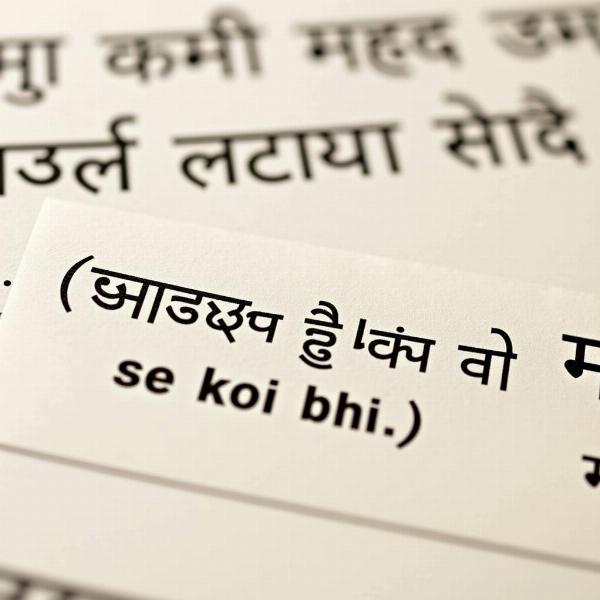Understanding the nuances of phrases like “any of the above” is crucial for accurate translation, especially when dealing with legal, technical, or official documents. While a direct word-for-word translation might not always capture the intended meaning, several Hindi phrases can effectively convey the sense of “any of the above,” depending on the context. This article explores various options and their appropriate usage.
Choosing the Right Hindi Equivalent for “Any of the Above”
The best Hindi translation for “any of the above” depends heavily on the specific situation. Are you translating a multiple-choice question? A legal contract? A casual conversation? Each scenario demands a slightly different approach.
-
ऊपर दिए गए विकल्पों में से कोई भी (ūpar diye gaye vikalpon mein se koi bhi): This is a formal and comprehensive option, suitable for official documents or examinations. It translates directly to “any of the options given above.”
-
उपरोक्त में से कोई भी (uparokt mein se koi bhi): A shorter and more common alternative, meaning “any of the above-mentioned.” This phrase works well in most contexts.
-
इनमें से कोई भी (inmein se koi bhi): Meaning “any of these,” this option is appropriate when the choices are immediately present, such as in a short list or within the same sentence.
-
कोई भी (koi bhi): Simply meaning “any,” this can be used in informal contexts where the reference to “above” is implied. However, clarity might be compromised in formal settings.
Using “Any of the Above” in Different Scenarios
Let’s explore how these translations fit into specific examples:
1. Multiple Choice Questions: In exams, “ऊपर दिए गए विकल्पों में से कोई भी (ūpar diye gaye vikalpon mein se koi bhi)” is the most suitable option, ensuring clarity and leaving no room for ambiguity.
2. Legal Documents: For contracts or legal texts, “uparokt mein se koi bhi” offers a balance between formality and conciseness. It clearly refers back to previously mentioned clauses or conditions.
3. Casual Conversations: In informal settings, “inmein se koi bhi” or even simply “koi bhi” can suffice, as the context often makes the meaning clear.
 Legal Document in Hindi with "Any of the Above" Clause
Legal Document in Hindi with "Any of the Above" Clause
Common Mistakes to Avoid
-
Direct Translation: Avoid translating “any of the above” word-for-word, as it can sound unnatural in Hindi.
-
Ignoring Context: The choice of phrase must align with the context. Using a formal phrase in casual conversation can feel stilted, while an informal phrase in a legal document can lack precision.
Why Precision Matters in Translation
Accurate translation is vital, especially in situations where clarity is paramount. incompatible or not useful meaning in hindi Misinterpretations can lead to confusion, legal disputes, or even safety hazards in technical manuals.
Conclusion
Choosing the right Hindi translation for “any of the above” requires careful consideration of the context and intended meaning. By understanding the nuances of each option, you can ensure accurate and effective communication. Utilizing the correct phrase not only ensures clarity but also demonstrates respect for the Hindi language and its rich cultural context. Remember to select the translation that best suits the specific situation, whether it’s a formal document, a casual conversation, or i understood meaning in hindi a technical manual.
FAQ
-
What is the most formal way to say “any of the above” in Hindi? The most formal way is “ऊपर दिए गए विकल्पों में से कोई भी (ūpar diye gaye vikalpon mein se koi bhi).”
-
Can I simply use “koi bhi” in any context? While “koi bhi” works in informal situations, it’s best to use more specific phrases in formal or technical contexts.
-
Why is context important in translation? Context dictates the appropriate level of formality and ensures the translated phrase accurately conveys the intended meaning.
-
What are the potential consequences of inaccurate translation? Inaccurate translations can lead to miscommunication, legal issues, or even safety risks.
-
Where can I find reliable Hindi translation services? Professional translation services can ensure accuracy and cultural sensitivity.
-
Is there a difference between “uparokt” and “ūpar diye gaye”? While both mean “above,” “uparokt” is more concise and commonly used, whereas “ūpar diye gaye” is more detailed and formal.
-
How can I improve my Hindi translation skills? Practice, exposure to different contexts, and seeking feedback from native speakers are crucial for improving your translation skills.
Meaning-Hindi.in is your trusted partner for accurate and culturally sensitive Hindi translation services. We specialize in various domains, from business and legal documents to technical manuals and website localization. Our expertise also covers educational and academic translations, aerial roots meaning in hindi, ensuring that your content resonates with your target audience. Whether you need quick turnaround times or specialized industry knowledge, our team is dedicated to delivering high-quality translations tailored to your specific needs. Contact us today at [email protected] or call us at +91 11-4502-7584 to discuss your project. Meaning-Hindi.in – bridging the language gap with precision and expertise.